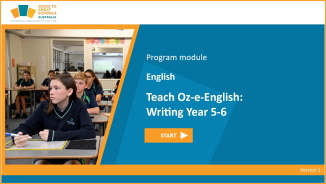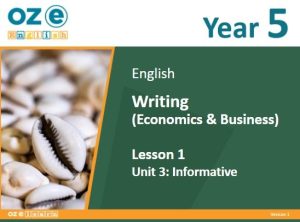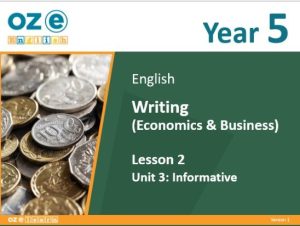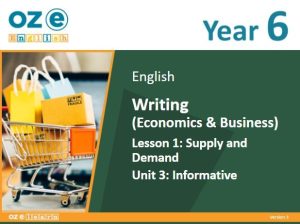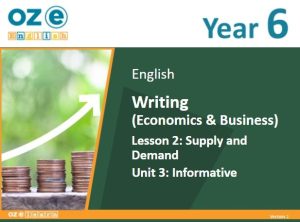Oz-e-English Writing (Economics & Business) Years 5-6
Unit 3: Informative
The Writing (Economics & Business) units align to the Australian Curriculum Content Descriptions for Language and Literacy
Free Starter Lessons
Year Overview
Year 5
Australian Curriculum Content Descriptions
Unit 3: Informative – Year 5 is an English language strand unit for Year 5 students. It aligns to the Australian Curriculum: English Year Level Achievement Standards:
- Plan, draft and publish imaginative, informative and persuasive print and multimodal texts, choosing text structures, language features, images and sound appropriate to purpose and audience (ACELY1704).
- Reread and edit student’s own and others’ work using agreed criteria for text structures and language features (ACELY1705).
It aligns to the Australian Curriculum: Economics and Business Year Level Achievement Standards:
- The difference between needs and wants and why choices need to be made about how limited resources are used (ACHASSK119).
- Types of resources: natural, human, capital and the ways societies use them to satisfy the needs and wants of present and future generations (ACHASSK120).
Note: The content on this page is subject to change as this program is being updated to comply with Australian Curriculum version 9.0 so may change at any time. GGSA will issue an updated version in the first quarter of 2024.
Learning Objectives
In Lessons 1 to 45, students will:
Examine the text structure and language features of informative texts in the learning area of Business and Economics.
Examine eight economics and business themes that are discussed in informative exemplar texts:
- Sharing in Economics
- Bartering as a Transaction
- Enterprise and Entrepreneurs
- Markets in Economics
- What are Resources?
- Production: Making Things to Sell
- Choosing Needs and Wants in Economics
- Labour and Wages in Economics.
Analyse the text structure, ideas, synthesis of information and language aspects of informative materials related to the study of business and economics.
Analyse and construct sentence and paragraph structure within informative texts.
Success Criteria
- Identify the structure of an information report.
- Identify the meaning of topics about economics and business.
- Identify and write informative sentences and express information about an idea.
Identify and write ideas that link to inform paragraphs. - Jointly construct informative sentences and paragraphs that present ideas about economics and business.
- Plan, draft, write and edit an information report in the generic structure.
Assessment
Progress Tests
- A total of four progress tests worth a combined 40 per cent of the final grade are conducted in Weeks 2, 4, 6, and 9.
- Progress tests enable teachers to keep track of their students’ learning of the material covered and pinpoint areas that require additional instruction.
- The Student Workbook contains progress tests.
End-of-Unit Assessment
- The end-of-unit assessment is given in Week 7, which contributes 60 per cent of the total grade.
- Each unit’s success criterion is addressed by this assessment, which is part of the Student Workbook.
Year 6
Australian Curriculum Content Descriptions
Overview
Unit 3: Informative – Year 6 is an English language strand unit for Year 6 students. It aligns to the Australian Curriculum: English Year Level Achievement Standards:
- Publication.
- Use comprehension strategies such as visualising, predicting, connecting, summarising, monitoring, and questioning to build literal and inferred meaning, and to connect and compare content from a variety of sources (AC9E6LY05).
- Use interaction skills and awareness of formality when paraphrasing, questioning, clarifying and interrogating ideas and developing and supporting arguments and sharing and evaluating information, experiences and opinions (AC9E6LY02).
- Analyse how text structures and language features work together to meet the purpose of a text, and engage and influence audiences (AC9E6LY03).
It also aligns to the Australian Curriculum: Economics and Business Year Level Achievement Standards:
- Influences on consumer choices and strategies that can be used to help make informed personal consumer and financial choices (AC9HS6K08).
- Present descriptions and explanations, drawing ideas, findings and viewpoints from sources, and using relevant terms and conventions (AC9HS6S07).
Learning Objectives
In Lessons 1-45, students will examine eight economics and business themes that are discussed in informative exemplar texts:
- Supply and Demand
- Inventions and Commodities
- Enterprise and Entrepreneurs
- Companies
- Competition
- E-Commerce
- Pricing Nature
- Money.
They will also recognise the graphic aspects, language, and structural components of instructive writings, and write educational texts on business and economics.
Success Criteria
- Identify key vocabulary from the text.
Identify the meaning of Economics and Business topics. - Understand the purpose of informative texts.
- Identify the text features of informative texts.
- Jointly plan information reports based on the exemplar texts.
- Independently plan, write and edit informative texts.
- Create a product and a marketing campaign.
Assessment
Progress test
- A total of four progress tests worth a combined 40 per cent (20 per cent Writing – 20 per cent Economics and Business) of the final grade are conducted in Weeks 2, 4, 6, and 9.
- Progress tests enable teachers to keep track of their students’ learning of the material covered and pinpoint areas that require additional instruction.
- The Student Workbook contains progress tests.
End-of-Unit Assessment
- The end-of-unit assessment is given in Week 7, which contributes 60 per cent (30 per cent Informative Writing and 30 per cent Economics and Business) of the total grade.
- The assessment covers five consecutive tasks covering five Economics and Business topics supported by five Power Points. Each unit success criterion is addressed by this assessment, which is part of the Student Workbook.
Other Units
Lesson Design
Lesson Objective
Success Criteria
Activating Prior Knowledge
I Do
We Do
Apple Question
You Do
Revise
Professional Learning
